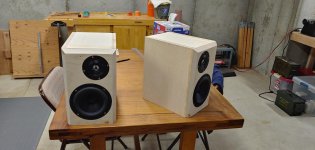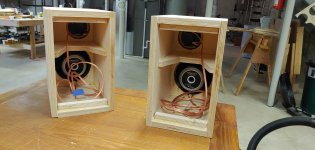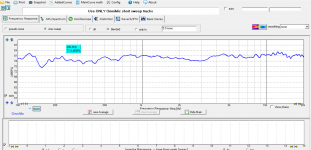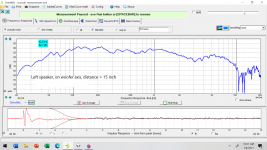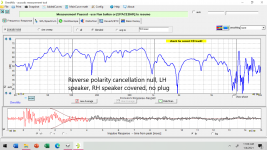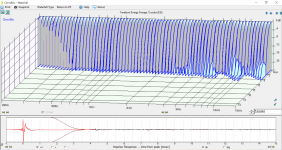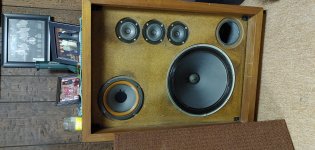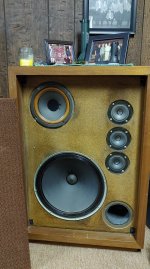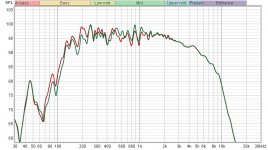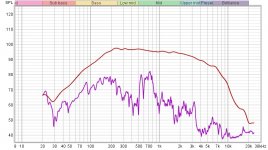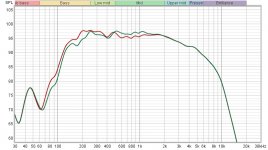The woofers are decoupled in the 105 series2 by three soft rubber mounts and a soft gasket which is attached only to the basket resting against the cab.
Hmm, back to my earlier post, I wonder if gel insoles for running shoes could be cut up for this purpose?two-piece brace supporting opposite walls with a visco-elastic material joining them
BUT still maybe missing ("maybe" cuz I didn't realize this thread had ballooned to 31 pages and I haven't read them all) is some accelerometer I can just BUY...(there was one candidate from Mouser I think, considering that...)
Have you seen that online? I have been scrounging but cannot find that. The ironic part being, I surely read the article at the time...There is an article in Audio Xpress, june 2011,"Accelerometer Testing of Loudspeaker Drivers" and within there is reference to cabinet panels.
Sounds like I'm not the only one who needs to experiment with bracing 😉I checked to see if there was any bracing, and there was not! I am totally shocked by this!
(Easiest is to cut 1x1 or dowel rod a *little bit* too long, then jam it in there. That is at least a simple, removable way to try stiff bracing. My current idea #2 is cutting thick gel pad, like maybe shoe inserts, same 1x1/dowel but with some kind of wider piece on the gel, so it doesn't get pierced. Unless your post #177 is already trying something like this? It didn't really say)
Somewhat answering my original query, I'd answer that once you have a UMIK or such running into REW perhaps it is simpler to look at distortion and impedance sweeps, than trying to measure panel vibrations a lot of different places. And cheaper in that you use existing hardware instead of buying new. I still haven't decided, not in a hurry. My next move will actually be the calibrated UMIK-1 but there is not stock right now. 😡Why not just use an accelerometer to start with.
Well, Stereophile does sometimes comment about the accelerometer measurements versus something called out in the listening tests. But not always.I don't think that an audibility check has ever been done before on an actual accelerometer measurement of a loudspeaker panel until now. Please correct me if I'm wrong🙂
For me, if I can make a big enclosure more dead, it's good. Even if I can't be sure it's audible, putting in bracing and anti-vibration goop and stuffing is just not that hard or expensive an experiment to undertake, and I had great results once which I forget if I mentioned with just such upgrades. My best friend's husband STILL refuses to sell those speakers.
The obvious point is there are many more people already measuring panel behavior with accelerometers and running FFT on the results. I think that this thread should actually be two different threads. The original was asking about purchasing accelerometers which has been answered
The second on the audibility of panel behavior which is a is very worth pursuing.
The second on the audibility of panel behavior which is a is very worth pursuing.
I did another session of evaluating a pair of speaker cabinets using the Remlab face-to-face cancellation technique (need a better name, too hard to type).
I evaluated my basement workshop speakers which I built over the summer. These use an SB17MFC35 6 inch poly cone woofer and a 30 year old Vifa aluminum dome tweeter, crossed at 2k (passive crossover). Request Peer review of crossover
These cabinets are very conventional. Unlike my main system, I did not go all-out in making the cabinets highly stiff. Cabinets are 19mm baltic birch ply, and the front baffle is doubled to 38mm. There is a single horizontal shelf brace. I show the on-axis response as measured back in July.
I evaluated my basement workshop speakers which I built over the summer. These use an SB17MFC35 6 inch poly cone woofer and a 30 year old Vifa aluminum dome tweeter, crossed at 2k (passive crossover). Request Peer review of crossover
These cabinets are very conventional. Unlike my main system, I did not go all-out in making the cabinets highly stiff. Cabinets are 19mm baltic birch ply, and the front baffle is doubled to 38mm. There is a single horizontal shelf brace. I show the on-axis response as measured back in July.
Attachments
The first step in performing the Remlab test was to reverse polarity of one of the speakers. Then I made a baseline measurement of the left speaker. I made this baseline at 90 dB at a distance of 15 inches, on the woofer axis.
The next step was to position both speakers facing each other as close as possible. I covered the right hand speaker with many layers of absorbant blankets, more than 16 layers. I took a FR of the side panel of the left speaker. The response was approximately 70 dB, which shows I was getting a good cancellation null.
There does not appear to be any resonance peaks. The response is fairly uniform at -20 dB below the baseline up to 700 Hz, then it shelves down by another 10 dB.
Listening impressions of the nulled-out speaker: Surprisingly positive. Listening to piano, big band, and female opera, the sound of the cabinet was nice. No ringing, buzzing, or peaky sound. There was no impression of resonance. No sound that I would associate with delayed energy. It sounded like a quiet version of the speaker, with a gentle filtering of the sound above 1k, almost like a first order roll-off above 1k. I am convinced that sound would be completely masked by the direct sound of the drivers.
Of the sound I was hearing, I can not be sure how much was cabinet radiation and how much was ineffective cancellation null (i.e. non-cancelled driver sound). But what I CAN be sure of is that whatever cabinet radiation was present was at least 20 dB below the direct sound from the drivers. I can also be sure that whatever cabinet radiation was present did not include any intrusive ringing or delayed energy. Such cabinet mis-behavior would have been easy to detect with the main drivers nulled out down to -20 dB.
So I am more convinced than before on the value and utility of the Remlab face-to-face cancellation technique. I am also starting to believe that cabinet radiation is probably not audible unless it is quite bad.
The next step was to position both speakers facing each other as close as possible. I covered the right hand speaker with many layers of absorbant blankets, more than 16 layers. I took a FR of the side panel of the left speaker. The response was approximately 70 dB, which shows I was getting a good cancellation null.
There does not appear to be any resonance peaks. The response is fairly uniform at -20 dB below the baseline up to 700 Hz, then it shelves down by another 10 dB.
Listening impressions of the nulled-out speaker: Surprisingly positive. Listening to piano, big band, and female opera, the sound of the cabinet was nice. No ringing, buzzing, or peaky sound. There was no impression of resonance. No sound that I would associate with delayed energy. It sounded like a quiet version of the speaker, with a gentle filtering of the sound above 1k, almost like a first order roll-off above 1k. I am convinced that sound would be completely masked by the direct sound of the drivers.
Of the sound I was hearing, I can not be sure how much was cabinet radiation and how much was ineffective cancellation null (i.e. non-cancelled driver sound). But what I CAN be sure of is that whatever cabinet radiation was present was at least 20 dB below the direct sound from the drivers. I can also be sure that whatever cabinet radiation was present did not include any intrusive ringing or delayed energy. Such cabinet mis-behavior would have been easy to detect with the main drivers nulled out down to -20 dB.
So I am more convinced than before on the value and utility of the Remlab face-to-face cancellation technique. I am also starting to believe that cabinet radiation is probably not audible unless it is quite bad.
Attachments
I also thought about the radiation from the front baffle. I remembered that I made a Toneburst Energy Storage plot (similar to a CSD waterfall plot). This plot is normalized to the on-axis response. It has no resolution below 400 Hz due to the gating window.
If there was resonant baffle behavior in the baffle (above 400 Hz), I believe it would show up on this plot. All I see is some tweeter resonances above 5k. There is not much in the 400 Hz to 1500 hz "cabinet radiation" region.
Once again, this is a very conventionally constructed cabinet, nothing fancy... and I just don't see or hear much cabinet signature.
Maybe we have been over thinking this whole problem?
J.
If there was resonant baffle behavior in the baffle (above 400 Hz), I believe it would show up on this plot. All I see is some tweeter resonances above 5k. There is not much in the 400 Hz to 1500 hz "cabinet radiation" region.
Once again, this is a very conventionally constructed cabinet, nothing fancy... and I just don't see or hear much cabinet signature.
Maybe we have been over thinking this whole problem?
J.
Attachments
Thanks for the graphs. We aren't over thinking it. Compared to the way speaker cabinets used to be built, I would call yours very high quality and rather solid. Simple, yes, but solid. And they are small. Think of the big old speaker cabinets of yesteryear. I can tell you for sure that they buzzed and sang. Fixing that was a major first step in speaker upgrades.
When I joined this forum 16 years ago after a long audio hiatus, I was surprised to see how solidly built many speaker projects were. It wasn't always like that. Nice work!
When I joined this forum 16 years ago after a long audio hiatus, I was surprised to see how solidly built many speaker projects were. It wasn't always like that. Nice work!

Good point. My Dad's 1968 "Aztec Monet" speakers were quite pricey in their day, with at least a 120 liter box, 15 inch woofer, and not a single stick of bracing.Think of the big old speaker cabinets of yesteryear.
When I build new satellites with the Textreme drivers, I am not going to try to improve on the cabinet construction technique I used before in my main system... It is good enough.
Attachments
Last edited:
Your time window isn't that big, I'd suggest using the double at least, but if you want to integrate resonances well enough, to me 8ms seems too short too.I took a FR of the side panel of the left speaker.
I tend to follow that, certainly for small speakers up til the classic 6"-1". Bigger cabinets probably will come out worse (a lot) easier.I am also starting to believe that cabinet radiation is probably not audible unless it is quite bad.
Okay, the cabinet audibility thing was really getting to me, so I did something ridiculously simple with one of my Dunlavy's. I Aimed it forward at the mic, and covered it up with many blankets, taking care to make sure that they didn't interfere with the front baffle radiation, and took measurements from the listening position(2 meters) vs no blankets at all and this is what I got. Can anyone poke holes in this? Is there something I'm not accounting for? For one, it seems like the side panel radiation in the bass is canceling out some of the foreword bass frequencies. The rest needs more interpretation. The first graph has an expanded vertical scale to differentiate the traces.
First graph;
Red - Blankets
green- Without blankets
Second graph;
Side panel acoustic measurements(null technique)
First graph;
Red - Blankets
green- Without blankets
Second graph;
Side panel acoustic measurements(null technique)
Attachments
Last edited:
This is probably a daft question, but shouldn't the trace without blankets be more bumpy through the mid band than with blankets, as the cabinet vibration cancels out some frequencies and reinforces others. Is the sound so directional from the side panels in the mids, that it just gets lost in the room?
- Home
- Loudspeakers
- Multi-Way
- Accelerometers to measure panel vibrations?
